The Effects of Turbine Guide Vanes on the Ignition Limit and Light-Round Process of a Triple-Dome Combustor
Abstract
:1. Introduction
2. Experimental Setup
2.1. Flow Configuration
2.2. Measurement Methods and Image Processing
3. Results and Discussion
3.1. Turbine Guide Vanes’ Effect on the Ignition Limits of the Triple-Dome Combustor
3.2. Analysis of Flame Propagation and Light-Round Processes
3.2.1. Turbine Guide Vane Fuel-to-Air Ratio Effect on the Light-Round Process
3.2.2. Mainstream Flow Rate Effect on the Light-Round Process
4. Summary
Author Contributions
Funding
Data Availability Statement
Conflicts of Interest
References
- Liu, D. The Development and Proposals of the Aeroengine Technology. Strateg. Study CAE 1999, 2, 24–29. [Google Scholar]
- Li, J.; Hu, Z. Design technology for high-temperature rise and high-heat capacity combustor. Gas Turbine Exp. Res. 2000, 13, 5–8. [Google Scholar]
- Escudier, M. Confined vortices in flow machinery. Annu. Rev. Fluid Mech. 1987, 19, 27–52. [Google Scholar] [CrossRef]
- Werschnik, H.; Hilgert, J.; Wilhelm, M.; Bruschewski, M.; Schiffer, H.-P. Influence of combustor swirl on endwall heat transfer and film cooling effectiveness at the large scale turbine rig. J. Turbomach. 2017, 139, 081007. [Google Scholar] [CrossRef]
- Aslanidou, I. Combustor and Turbine Aerothermal Interactions in Gas Turbines with Can Combustors. Ph.D Thesis, University of Oxford, Oxford, UK, 2016. [Google Scholar]
- Wang, G.; Xia, Y.; Ye, C.; Hu, K.; Linghu, C. Progress on light-round ignition dynamics in annular combustor. J. Exp. Fluid Mech. 2019, 33, 14–28. [Google Scholar]
- Ye, C.; Wang, G.; Fang, Y.; Ma, C. Ignition Dynamics in Annular Combustor with Turbine Guide Vanes. J. Combust. Sci. Technol. 2020, 26, 75–80. [Google Scholar]
- Wang, H.; Zhong, L.; Wang, G. Imaging Experiment Study of the Ignition Process in the Annular Combustion of Aero-engines. Adv. Aeronaut. Sci. Eng. 2019, 10, 861–866. [Google Scholar]
- Miki, K.; Moder, J.; Liou, M.S. Computational study of combustor–turbine interactions. J. Propuls. Power 2018, 34, 1529–1541. [Google Scholar] [CrossRef]
- Klapdor, E.V. Simulation of Combustor-Turbine Interaction in a Jet Engine. Ph.D. Thesis, Technische Universität Darmstadt, Darmstadt, Germany, 2011. [Google Scholar]
- Zhou, J.; Wan, P.-x.; Han, X.-s.; Mao, J.-k.; Bi, S.; Cai, K.-x. Very-Large Eddy Simulation of Turbulent Flow and Heat Transfer for Coupled Combustor-Turbine Components. J. Propuls. Technol. 2022, 43, 238–248. [Google Scholar]
- Wan, P.; Fan, J.; Han, X.; Mao, J. Very-large eddy simulation of impinging jet flow and heat transfer. J. Propuls. Technol. 2020, 41, 2237–2247. [Google Scholar]
- Machover, E.; Mastorakos, E. Spark ignition of annular non-premixed combustors. Exp. Therm. Fluid Sci. 2016, 73, 64–70. [Google Scholar] [CrossRef]
- Bach, E.; Kariuki, J.; Dawson, J.R.; Mastorakos, E.; Bauer, H.-J. Spark ignition of single bluff-body premixed flames and annular combustors. In Proceedings of the 51st AIAA Aerospace Sciences Meeting Including the New Horizons Forum and Aerospace Exposition, Grapevine, TX, USA, 7–10 January 2013; p. 1182. [Google Scholar]
- Barré, D.; Esclapez, L.; Cordier, M.; Riber, E.; Cuenot, B.; Staffelbach, G.; Renou, B.; Vandel, A.; Gicquel, L.Y.M.; Cabot, G. Flame propagation in aeronautical swirled multi-burners: Experimental and numerical investigation. Combust. Flame 2014, 161, 2387–2405. [Google Scholar] [CrossRef]
- Machover, E.; Mastorakos, E. Experimental investigation on spark ignition of annular premixed combustors. Combust. Flame 2017, 178, 148–157. [Google Scholar] [CrossRef]
- Mongia, H. Engineering aspects of complex gas turbine combustion mixers part I: High Delta-T. In Proceedings of the 49th AIAA Aerospace Sciences Meeting Including the New Horizons Forum and Aerospace Exposition, Orlando, FL, USA, 4–7 January 2011; p. 107. [Google Scholar]
- Philip, M.; Boileau, M.; Vicquelin, R.; Schmitt, T.; Durox, D.; Bourgouin, J.-F.; Candel, S. Simulation of the ignition process in an annular multiple-injector combustor and comparison with experiments. J. Eng. Gas Turbines Power 2015, 137, 031501. [Google Scholar] [CrossRef]
- Philip, M.; Boileau, M.; Vicquelin, R.; Schmitt, T.; Durox, D.; Bourgouin, J.-F.; Candel, S. Ignition sequence of an annular multi-injector combustor. Phys. Fluids 2014, 26, 091106. [Google Scholar] [CrossRef]
- Philip, M.; Boileau, M.; Vicquelin, R.; Riber, E.; Schmitt, T.; Cuenot, B.; Durox, D.; Candel, S. Large eddy simulations of the ignition sequence of an annular multiple-injector combustor. Proc. Combust. Inst. 2015, 35, 3159–3166. [Google Scholar] [CrossRef]
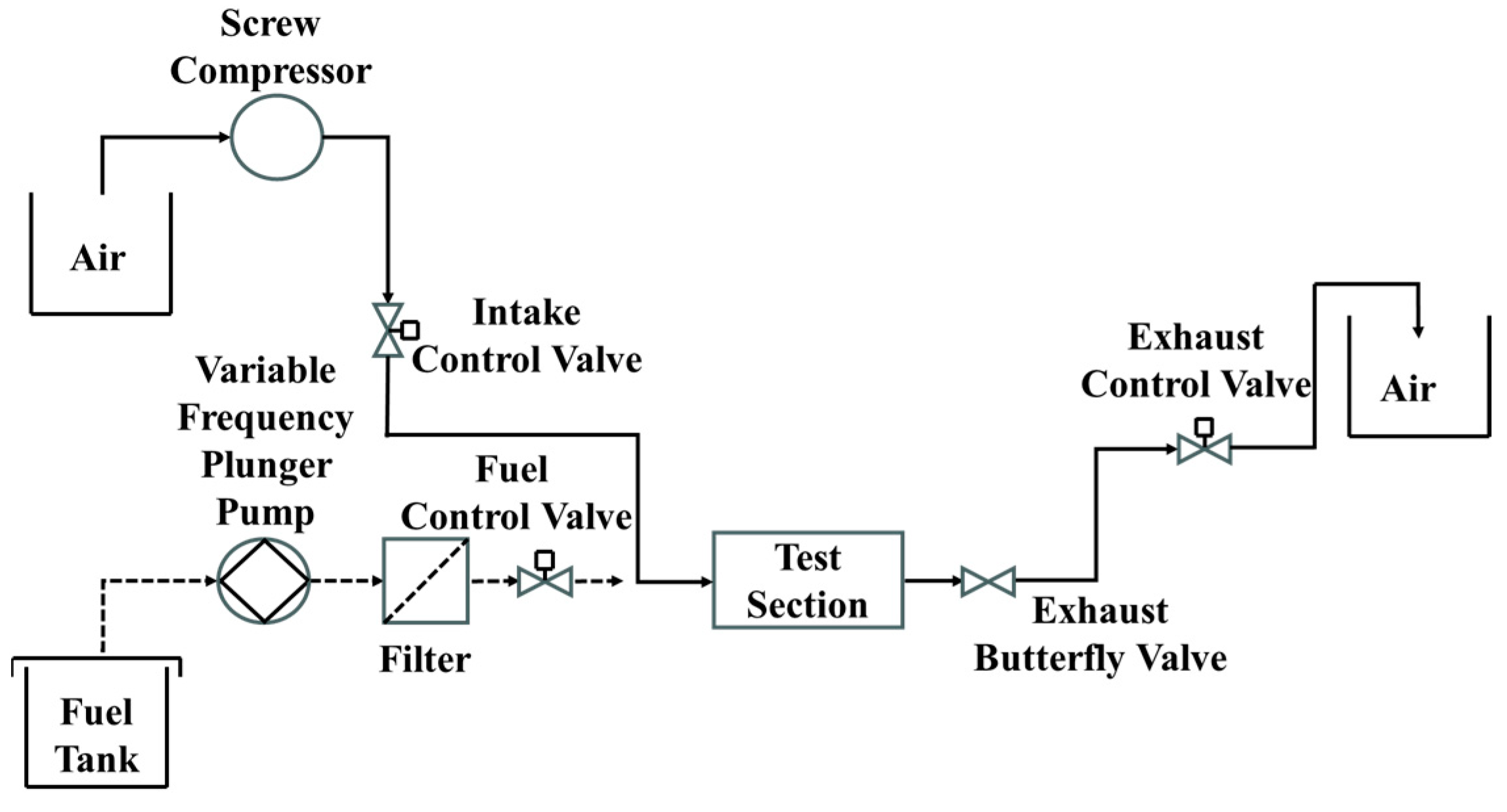
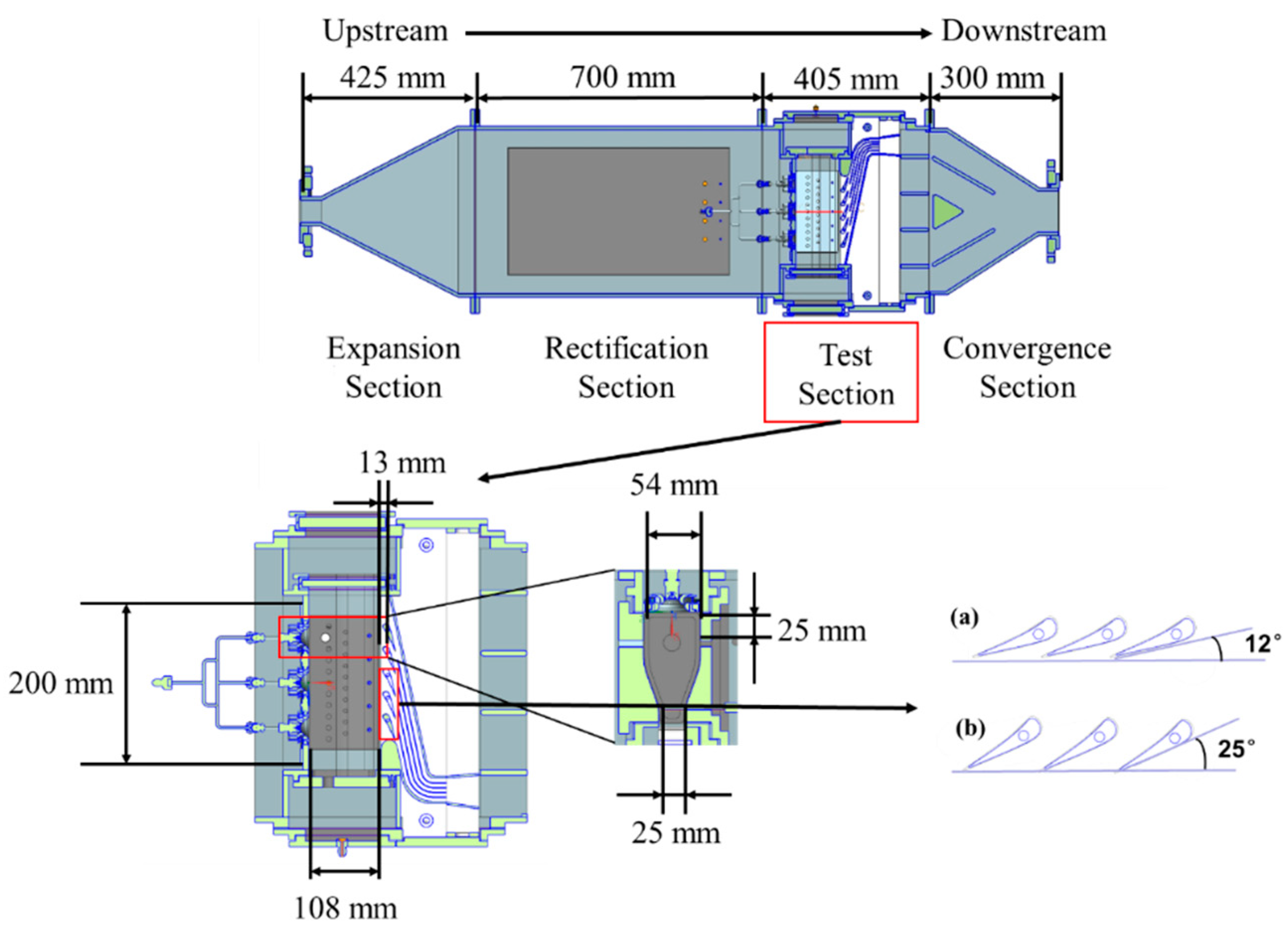

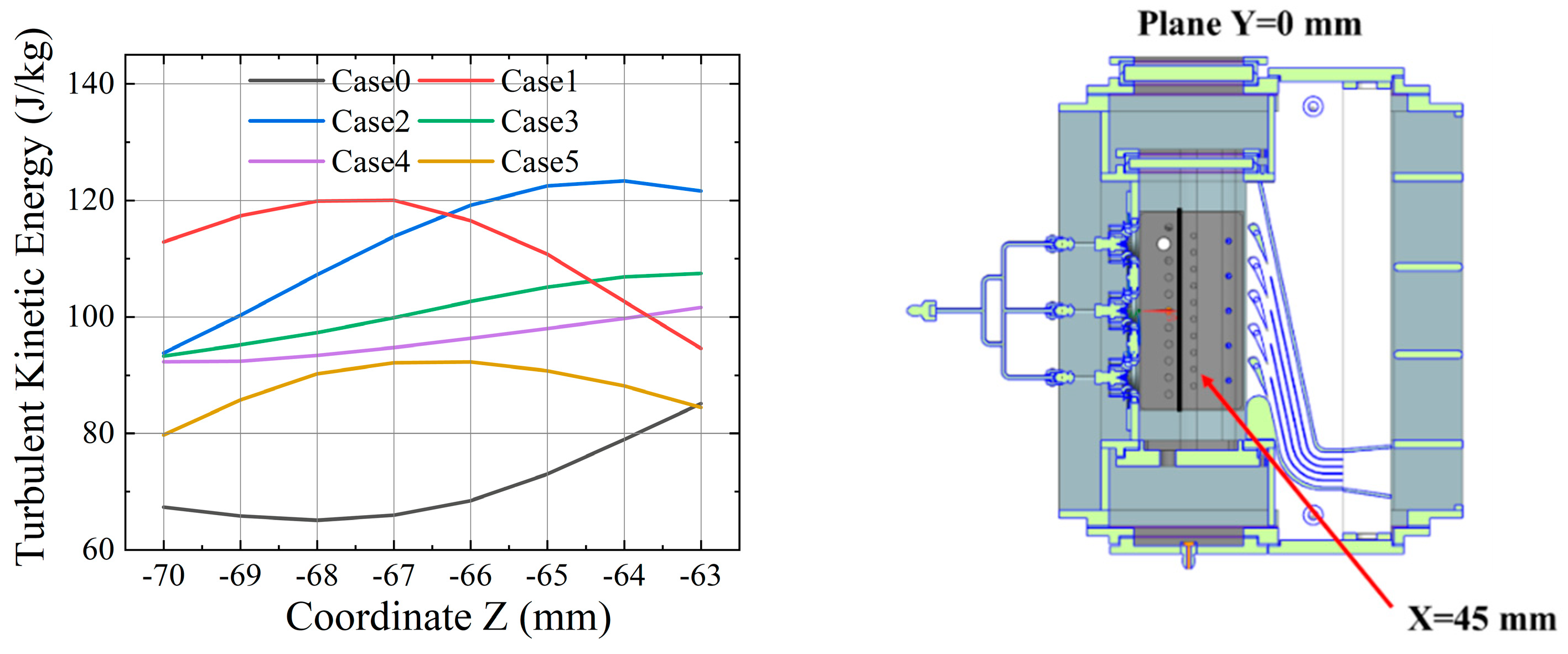


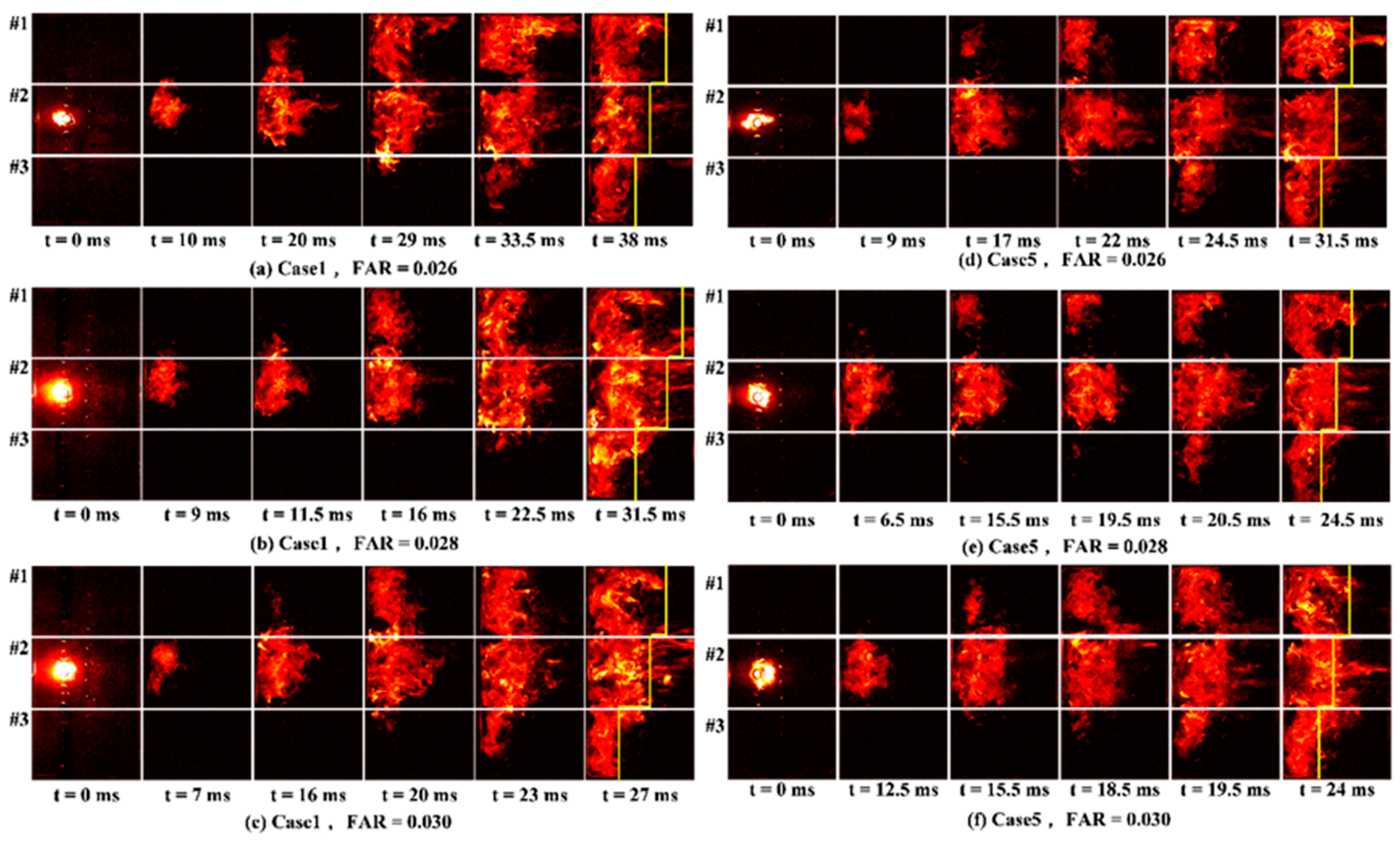
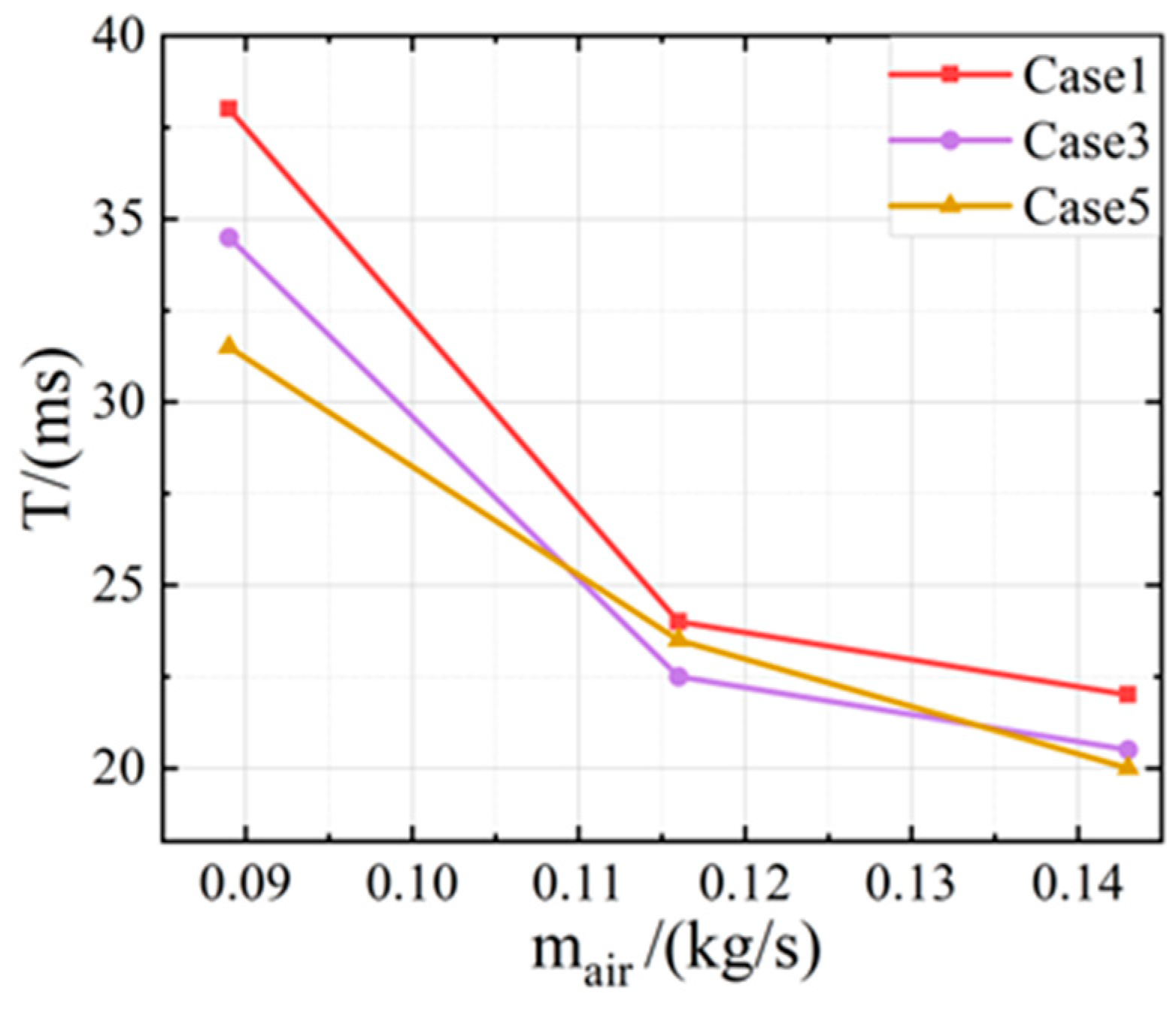

| Scheme | Turbine Guide | Blockage |
|---|---|---|
| Case0 | No | 0.00 |
| Case1 | Yes | 0.80 |
| Case2 | Yes | 0.75 |
| Case3 | Yes | 0.70 |
| Case4 | Yes | 0.65 |
| Case5 | Yes | 0.60 |
| mair/(kg/s) | mfuel/(kg/h) | Fuel-to-Air Ratio |
|---|---|---|
| 0.089 | 8.33 | 0.026 |
| 0.089 | 8.97 | 0.028 |
| 0.089 | 9.61 | 0.030 |
| mair/(kg/s) | mfuel/(kg/h) | Fuel-to-Air Ratio |
|---|---|---|
| 0.089 | 8.33 | 0.026 |
| 0.116 | 10.86 | 0.026 |
| 0.143 | 13.38 | 0.026 |
Disclaimer/Publisher’s Note: The statements, opinions and data contained in all publications are solely those of the individual author(s) and contributor(s) and not of MDPI and/or the editor(s). MDPI and/or the editor(s) disclaim responsibility for any injury to people or property resulting from any ideas, methods, instructions or products referred to in the content. |
© 2024 by the authors. Licensee MDPI, Basel, Switzerland. This article is an open access article distributed under the terms and conditions of the Creative Commons Attribution (CC BY) license (https://creativecommons.org/licenses/by/4.0/).
Share and Cite
Li, Z.; Zhang, X.; Wang, K.; Liu, F.; Ruan, C.; Yang, J.; Mu, Y.; Liu, C.; Xu, G. The Effects of Turbine Guide Vanes on the Ignition Limit and Light-Round Process of a Triple-Dome Combustor. Energies 2024, 17, 4636. https://doi.org/10.3390/en17184636
Li Z, Zhang X, Wang K, Liu F, Ruan C, Yang J, Mu Y, Liu C, Xu G. The Effects of Turbine Guide Vanes on the Ignition Limit and Light-Round Process of a Triple-Dome Combustor. Energies. 2024; 17(18):4636. https://doi.org/10.3390/en17184636
Chicago/Turabian StyleLi, Ziyan, Xiaoyan Zhang, Kaixing Wang, Fuqiang Liu, Changlong Ruan, Jinhu Yang, Yong Mu, Cunxi Liu, and Gang Xu. 2024. "The Effects of Turbine Guide Vanes on the Ignition Limit and Light-Round Process of a Triple-Dome Combustor" Energies 17, no. 18: 4636. https://doi.org/10.3390/en17184636







